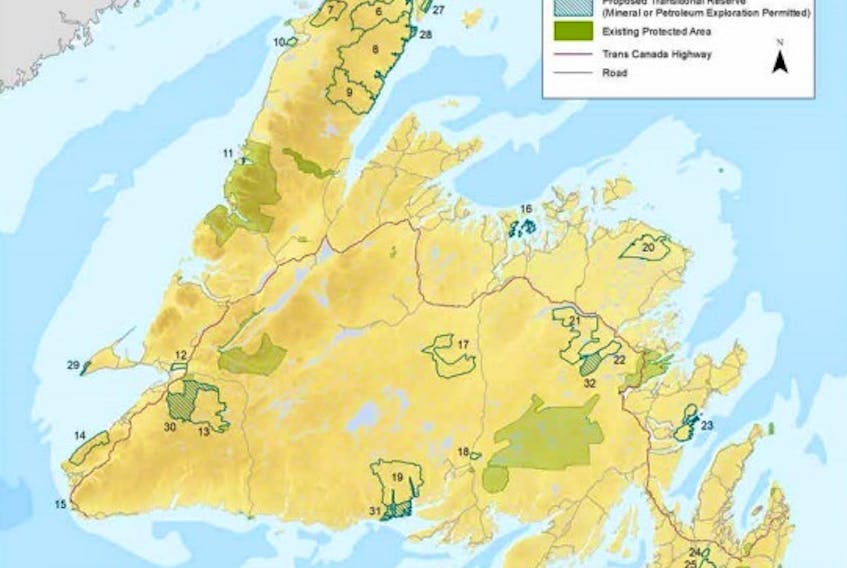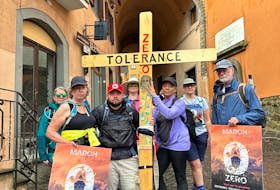ST. JOHN'S, N.L. — David Maher
The Telegram
@DavidMaherNL
An environmental protection plan 25 years in the making has been released, with public commentary invited until June 22.
The plan, released by the Wilderness and Ecological Reserves Advisory Council (WERAC), identifies 32 areas to be protected across the island portion of the province.
As The Telegram first reported in February, two members of the WERAC board — Bill Montevecchi and Victoria Neville — resigned in protest of continued delays in releasing the plan.
WERAC chair Graham Wood says it’s a relief to finally get the report in the hands of the public.
“We’re ecstatic, actually,” said Wood.
The proposed plan would see 8.7 per cent of the wilderness in the province protected. Currently, just 6.9 per cent of the province is protected — the third least across the country. While the plan doesn’t get the province to the 17 per cent protected area outlined by the United Nations, it’s a good place to start, Wood says.
“The whole rationale for this is to reach the 17 per cent goal of the UN conference on biodiversity, which Canada is committed to,” said Wood.
“We’re not there yet. Right now, we have 6.9, so we’re going up an extra couple of per cent. It’s a long-term plan. Each one of those representative areas, those 32 proposed protected areas, they’ll all go through public hearings.”
Under the proposed guidelines, new buildings, access roads, and trails are not permitted in protected areas. Any existing structures will be grandfathered into the plan. The report says there can still be business activity for nature-based businesses, such as outfitting.
“There are opportunities for nature-based businesses that are compatible with protected areas, such as outfitting and tourism. Establishing protected areas can increase business certainty for existing nature-based operations,” reads a question-and-answer complement to the report.
Certain kinds of hunting will still be permitted in the areas, depending on restrictions within each reserve.
“Hunting birds in a seabird reserve would not be permitted. Hunting, fishing and trapping are permitted in wilderness reserves and in select ecological reserves (for example, hunting and fishing is permitted in Watts Point and West Brook Botanical Ecological Reserves) as long as they do not cause damage,” reads the report.
“There may be restrictions on accessing a reserve or part of a reserve by certain methods.”
Those travelling by all-terrain vehicle or boat, for example, can continue to use existing paths in the reserve, but no new trails or docks would be constructed. Canoeing or kayaking will still be permitted within a protected area.
Some of the proposed areas will not become fully protected for another 10 years through the plan, to allow exploration of the areas for economic activities.
“It gives some of the mining interests time to do further exploration,” said Wood.
Wood says eventually a similar plan will be compiled and released for Labrador.
In a news release, the Nature Conservancy of Canada (NCC) applauded the release of the plan.
“I would like to commend the past and present volunteers on the Wilderness and Ecological Reserves Advisory Council for their dedicated work on this plan over many years,” stated Megan Lafferty, program director with the NCC.
“Our organization has a keen interest in seeing more land conserved in Newfoundland and Labrador — for wildlife, community recreation and climate change adaptation. We hope to see a high level of participation in the public consultation process.”
Suzanne Dooley, conservation director with the Newfoundland and Labrador chapter of the Canadian Parks and Wilderness Society, says it’s important for the public to engage with the plan and see it through its implementation.
“What we need now is residents to stand up and show their support for this plan, because the province is only giving us a small window to show that Newfoundlanders and Labradorians care about the wild spaces we’ve been so blessed with,” Dooley stated in a news release.
After the June 22 deadline for public comment, the report and commentary will go to cabinet for review.









